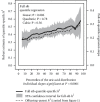Quantile-Dependent Expressivity of Serum Uric Acid Concentrations
- PMID: 34545327
- PMCID: PMC8448993
- DOI: 10.1155/2021/3889278
Quantile-Dependent Expressivity of Serum Uric Acid Concentrations
Abstract
Objective: "Quantile-dependent expressivity" occurs when the effect size of a genetic variant depends upon whether the phenotype (e.g., serum uric acid) is high or low relative to its distribution. Analyses were performed to test whether serum uric acid heritability is quantile-specific and whether this could explain some reported gene-environment interactions.
Methods: Serum uric acid concentrations were analyzed from 2151 sibships and 12,068 offspring-parent pairs from the Framingham Heart Study. Quantile-specific heritability from offspring-parent regression slopes (β OP, h 2 = 2β OP/(1 + r spouse)) and full-sib regression slopes (β FS, h 2 = {(1 + 8r spouse β FS)0.5 - 1}/(2r spouse)) was robustly estimated by quantile regression with nonparametric significance assigned from 1000 bootstrap samples.
Results: Quantile-specific h 2 (±SE) increased with increasing percentiles of the offspring's sex- and age-adjusted uric acid distribution when estimated from β OP (P trend = 0.001): 0.34 ± 0.03 at the 10th, 0.36 ± 0.03 at the 25th, 0.41 ± 0.03 at the 50th, 0.46 ± 0.04 at the 75th, and 0.49 ± 0.05 at the 90th percentile and when estimated from β FS (P trend = 0.006). This is consistent with the larger genetic effect size of (1) the SLC2A9 rs11722228 polymorphism in gout patients vs. controls, (2) the ABCG2 rs2231142 polymorphism in men vs. women, (3) the SLC2A9 rs13113918 polymorphism in obese patients prior to bariatric surgery vs. two-year postsurgery following 29 kg weight loss, (4) the ABCG2 rs6855911 polymorphism in obese vs. nonobese women, and (5) the LRP2 rs2544390 polymorphism in heavier drinkers vs. abstainers. Quantile-dependent expressivity may also explain the larger genetic effect size of an SLC2A9/PKD2/ABCG2 haplotype for high vs. low intakes of alcohol, chicken, or processed meats.
Conclusions: Heritability of serum uric acid concentrations is quantile-specific.
Copyright © 2021 Paul T. Williams.
Conflict of interest statement
The author declares that they have no conflicts of interest.
Figures




References
-
- Khanna D., Fitzgerald J. D., Khanna P. P., et al. 2012 American College of Rheumatology guidelines for management of gout. Part 1: systematic nonpharmacologic and pharmacologic therapeutic approaches to hyperuricemia. Arthritis Care & Research. 2012;64(10):1431–1446. doi: 10.1002/acr.21772. - DOI - PMC - PubMed
Grants and funding
LinkOut - more resources
Full Text Sources
Miscellaneous

